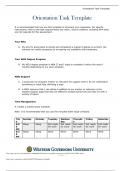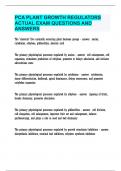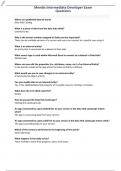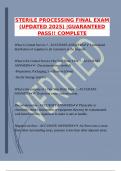ELECTROCHEMISTRY
Alex SOMI
2016 | 2017
,I. Principles
A. Electrode and cell potentials
B. Movement of ions in solution
1. Introduction
- The movement of ions in an electrochemical cell is essential because it allow to have
a closed loop in the system. This movement is composed of three components:
• Convection: concerns all the species.
• Diffusion: due to a gradient of concentration and it concerns all the species.
• Migration: due to the electric field and it concerns the charged species.
2. Molar flux and driving forces
- The molar flux of a specie i is defined as !" = $" %" where ci is the concentration of the
specie i in the solution and vi the velocity of this specie.
We also defined the molar flux of a specie i relative to the solvent (= reference) as:
!"& = $" %" − %& = $" %"&
- The molar flux occurs due to a driving force in the solution à driving force obtained
when we have a variation of electrochemical potential:
∇*+ = ∇*" + -" . ∇/
with *" the chemical potential and / the electric potential.
The expression of the molar flux should have a dependence in the variation of
electrochemical potential:
4"1&
!"& = −$" 0&"1 ∇*3 = −$" ∇*3
56
12& 12&
:
789
where 0&"1 = is a proportionality coefficient and 4"1& the diffusion coefficient. The
;<
molar flux relative to the solvent is proportional to the sum of the variation of the
electrochemical potential à influence of the j other species (but not the solvent !) on
the specie i. Note the minus sign because the flux is opposite direction of the gradient.
To find now the molar flux of the specie i (absolute now), we have to consider the flux
due to the solvent too:
!" = !"& + $" %&
The first term is the molar flux relative to the solvent (à depends on the
electrochemical potential) and the second one the flux due to convection (à no
dependence on the electrochemical potential). After some calculations:
4"1& 4"1&
!" = −$" ∇*3 + $" %& = −$" (∇*" + -" . ∇/) + $" %&
56 56
12& 12&
2
, but ∇*" = ∇ ?"@ + 56ABC" = ∇ 56ABC"
1
⟺ !" = −$" 4"1& ∇ABC" − $ -" .4"1& ∇/ + $" %&
56 "
12& 12&
where
• First term = diffusion (cf diffusion coefficient)
• Second term = migration (cf electric potential)
• Third term = convection (no dependence on *3 )
3. Simplified model
- The expression obtained previously is too difficult to work with because of the number
of species involved à three assumptions to consider in order to simplify the model:
ü Diluted solution: influence of only one specie, no interaction from the others
à all the sum symbols removed and %& ≈ %
ü Ideal solution à G" = 1 → C" = $"
ü With excess supporting electrolyte: the solution becomes very conductive à
no electrical potential gradient.
The simplified model can be written as !" = −4" I$" + $" %
4. Focus on diffusion
- By considering a one dimensional case and without convection and migration:
J$"
!" = −4"
JK
and we obtain the Fick’s law.
5. Focus on migration
- Microscopic description. We assume no concentration gradients in the solution:
-" .
!" = $ 4 ∇/ + $" %&
56 " "
LM
⟺ $" % − $" %& = 8 $" 4" ∇/
;<
-" .
⟺ % − %& = 4 ∇/ = ?" ∇/
56 "
The relative velocity of the specie i is proportional to the electric field gradient and the
proportional coefficient is the mobility of the specie i [m2 s-1 V-1].
- Macroscopic description à we are interested in the current density js of all the species
(obtained by multiplying the molar flux par the charge z and the Faraday constant):
à
3
Alex SOMI
2016 | 2017
,I. Principles
A. Electrode and cell potentials
B. Movement of ions in solution
1. Introduction
- The movement of ions in an electrochemical cell is essential because it allow to have
a closed loop in the system. This movement is composed of three components:
• Convection: concerns all the species.
• Diffusion: due to a gradient of concentration and it concerns all the species.
• Migration: due to the electric field and it concerns the charged species.
2. Molar flux and driving forces
- The molar flux of a specie i is defined as !" = $" %" where ci is the concentration of the
specie i in the solution and vi the velocity of this specie.
We also defined the molar flux of a specie i relative to the solvent (= reference) as:
!"& = $" %" − %& = $" %"&
- The molar flux occurs due to a driving force in the solution à driving force obtained
when we have a variation of electrochemical potential:
∇*+ = ∇*" + -" . ∇/
with *" the chemical potential and / the electric potential.
The expression of the molar flux should have a dependence in the variation of
electrochemical potential:
4"1&
!"& = −$" 0&"1 ∇*3 = −$" ∇*3
56
12& 12&
:
789
where 0&"1 = is a proportionality coefficient and 4"1& the diffusion coefficient. The
;<
molar flux relative to the solvent is proportional to the sum of the variation of the
electrochemical potential à influence of the j other species (but not the solvent !) on
the specie i. Note the minus sign because the flux is opposite direction of the gradient.
To find now the molar flux of the specie i (absolute now), we have to consider the flux
due to the solvent too:
!" = !"& + $" %&
The first term is the molar flux relative to the solvent (à depends on the
electrochemical potential) and the second one the flux due to convection (à no
dependence on the electrochemical potential). After some calculations:
4"1& 4"1&
!" = −$" ∇*3 + $" %& = −$" (∇*" + -" . ∇/) + $" %&
56 56
12& 12&
2
, but ∇*" = ∇ ?"@ + 56ABC" = ∇ 56ABC"
1
⟺ !" = −$" 4"1& ∇ABC" − $ -" .4"1& ∇/ + $" %&
56 "
12& 12&
where
• First term = diffusion (cf diffusion coefficient)
• Second term = migration (cf electric potential)
• Third term = convection (no dependence on *3 )
3. Simplified model
- The expression obtained previously is too difficult to work with because of the number
of species involved à three assumptions to consider in order to simplify the model:
ü Diluted solution: influence of only one specie, no interaction from the others
à all the sum symbols removed and %& ≈ %
ü Ideal solution à G" = 1 → C" = $"
ü With excess supporting electrolyte: the solution becomes very conductive à
no electrical potential gradient.
The simplified model can be written as !" = −4" I$" + $" %
4. Focus on diffusion
- By considering a one dimensional case and without convection and migration:
J$"
!" = −4"
JK
and we obtain the Fick’s law.
5. Focus on migration
- Microscopic description. We assume no concentration gradients in the solution:
-" .
!" = $ 4 ∇/ + $" %&
56 " "
LM
⟺ $" % − $" %& = 8 $" 4" ∇/
;<
-" .
⟺ % − %& = 4 ∇/ = ?" ∇/
56 "
The relative velocity of the specie i is proportional to the electric field gradient and the
proportional coefficient is the mobility of the specie i [m2 s-1 V-1].
- Macroscopic description à we are interested in the current density js of all the species
(obtained by multiplying the molar flux par the charge z and the Faraday constant):
à
3










